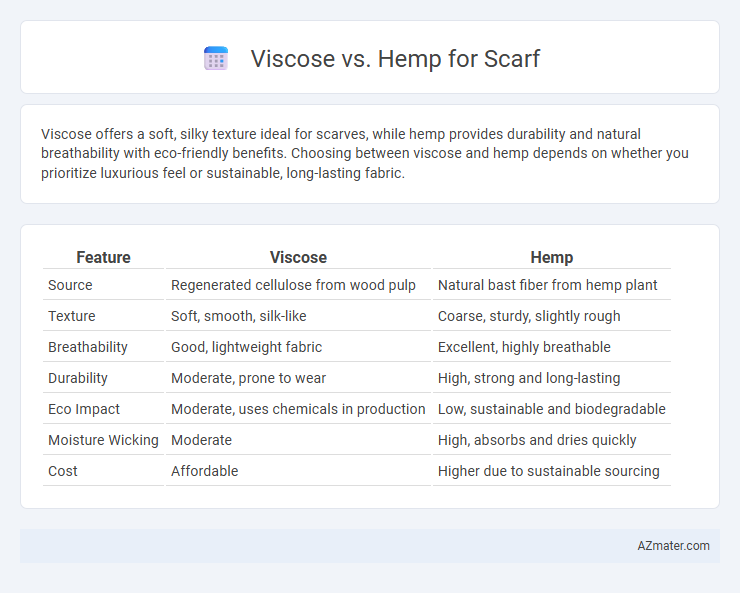Viscose offers a soft, silky texture ideal for scarves, while hemp provides durability and natural breathability with eco-friendly benefits. Choosing between viscose and hemp depends on whether you prioritize luxurious feel or sustainable, long-lasting fabric.
Table of Comparison
| Feature | Viscose | Hemp |
|---|---|---|
| Source | Regenerated cellulose from wood pulp | Natural bast fiber from hemp plant |
| Texture | Soft, smooth, silk-like | Coarse, sturdy, slightly rough |
| Breathability | Good, lightweight fabric | Excellent, highly breathable |
| Durability | Moderate, prone to wear | High, strong and long-lasting |
| Eco Impact | Moderate, uses chemicals in production | Low, sustainable and biodegradable |
| Moisture Wicking | Moderate | High, absorbs and dries quickly |
| Cost | Affordable | Higher due to sustainable sourcing |
Introduction to Viscose and Hemp Scarves
Viscose scarves offer a soft, smooth texture with excellent draping qualities, made from regenerated cellulose fibers derived from wood pulp, providing a lightweight and breathable option. Hemp scarves are crafted from natural hemp fibers known for their durability, breathability, and eco-friendly properties, featuring a slightly coarse texture that softens with use. Both materials cater to different preferences, with viscose delivering luxurious comfort and hemp emphasizing sustainability and rugged strength.
Origins and Production Processes
Viscose is a semi-synthetic fiber derived from regenerated cellulose typically sourced from wood pulp, produced through a chemical-intensive process involving alkali and carbon disulfide to create a soft, silk-like fabric. Hemp, a natural fiber obtained from the stalks of the Cannabis sativa plant, undergoes minimal processing that includes retting, decortication, and spinning, resulting in a durable and breathable textile. The eco-friendly cultivation of hemp contrasts with viscose production's environmental challenges due to chemical usage and deforestation concerns.
Environmental Impact Comparison
Viscose production involves chemically processing cellulose from wood pulp, resulting in significant water pollution and deforestation concerns, whereas hemp cultivation requires minimal pesticides and regenerates soil health, making it highly sustainable. Hemp fibers are biodegradable and have a lower carbon footprint due to their fast growth and minimal resource demands compared to viscose. Choosing hemp scarves supports eco-friendly fashion by reducing chemical waste and promoting renewable agriculture.
Texture and Comfort Differences
Viscose scarves offer a smooth, silky texture that feels lightweight and breathable against the skin, making them ideal for soft, comfortable wear. Hemp scarves have a coarser, more textured feel with natural fiber strength, providing durability but a slightly rougher touch that softens over time with use. The choice depends on whether you prioritize immediate softness and drape (viscose) or eco-friendly resilience and evolving comfort (hemp).
Durability and Longevity
Hemp fibers exhibit superior durability and longevity compared to viscose, maintaining strength through repeated wear and washing without significant degradation. Viscose, derived from wood pulp, tends to weaken and lose shape over time, especially when exposed to moisture and friction. Scarves made from hemp offer longer-lasting resilience, making them a sustainable choice for extended use.
Breathability and Moisture Wicking
Hemp scarves offer superior breathability due to their natural fiber structure, allowing better air circulation and temperature regulation compared to viscose. Hemp's inherent moisture-wicking properties draw sweat away from the skin, keeping the wearer dry and comfortable during extended use. Viscose, while soft and smooth, tends to retain moisture longer, making it less effective in temperature control and airflow for scarves.
Color Retention and Dyeing Qualities
Viscose offers excellent color retention with vibrant hues that remain bright after multiple washes, making it a preferred choice for scarves that require rich, consistent dyeing. Hemp fibers, while naturally textured and eco-friendly, tend to absorb dyes less uniformly, resulting in a more muted color palette and slightly faster fading over time. Overall, viscose excels in dye affinity and long-lasting color saturation compared to the more rustic appearance and variable dye uptake of hemp scarves.
Maintenance and Care Guidelines
Viscose scarves require gentle hand washing with cold water and mild detergent to prevent fiber weakening and color fading, while avoiding direct sunlight during drying to maintain fabric softness and shape. Hemp scarves benefit from machine washing on a gentle cycle with cold water, and air drying flat to prevent shrinkage and preserve the natural texture and durability of hemp fibers. Both materials should avoid bleach and excessive heat exposure to extend scarf lifespan and retain quality.
Price and Affordability
Viscose scarves are generally more affordable, with prices ranging from $10 to $30, making them an accessible option for budget-conscious shoppers. Hemp scarves tend to be priced higher, often between $30 and $70, due to their sustainable production methods and durable fiber qualities. Choosing viscose offers cost savings, while hemp provides long-term value through durability and eco-friendliness.
Which Scarf Material is Best for You?
Viscose scarves offer a silky texture and vibrant color retention, making them ideal for those seeking lightweight softness and elegance. Hemp scarves provide durability, breathability, and natural antibacterial properties, perfect for environmentally conscious individuals wanting sustainable and long-lasting accessories. Choosing between viscose and hemp depends on whether you prioritize luxurious feel and drape or eco-friendly strength and moisture-wicking comfort.

Infographic: Viscose vs Hemp for Scarf
 azmater.com
azmater.com